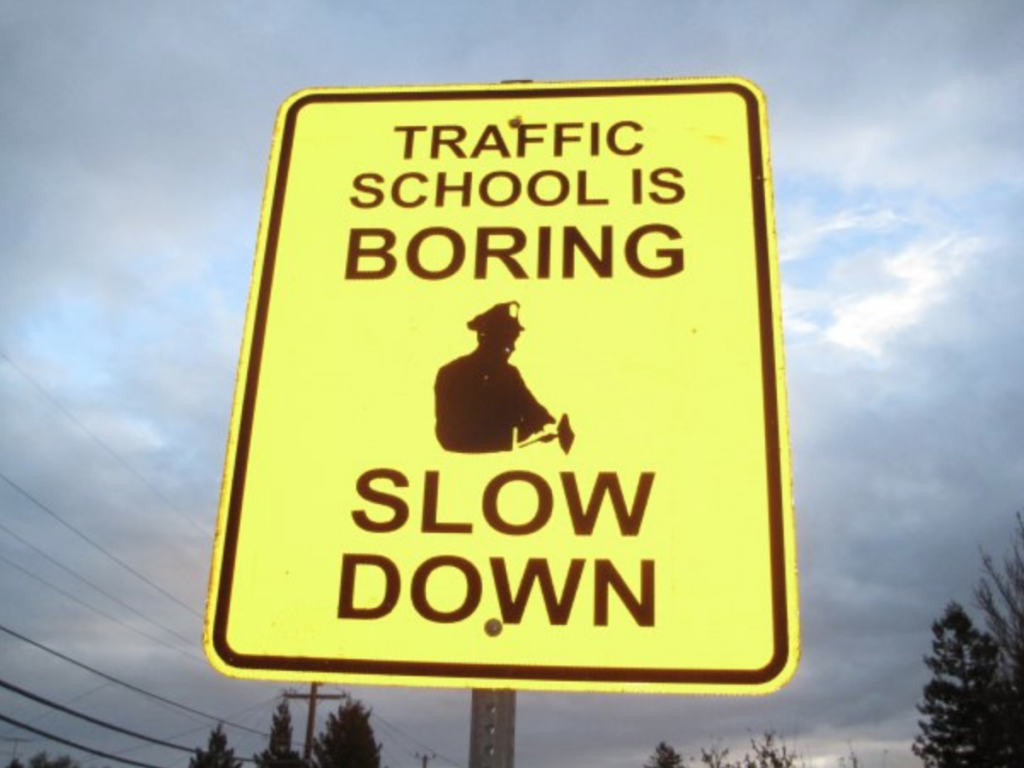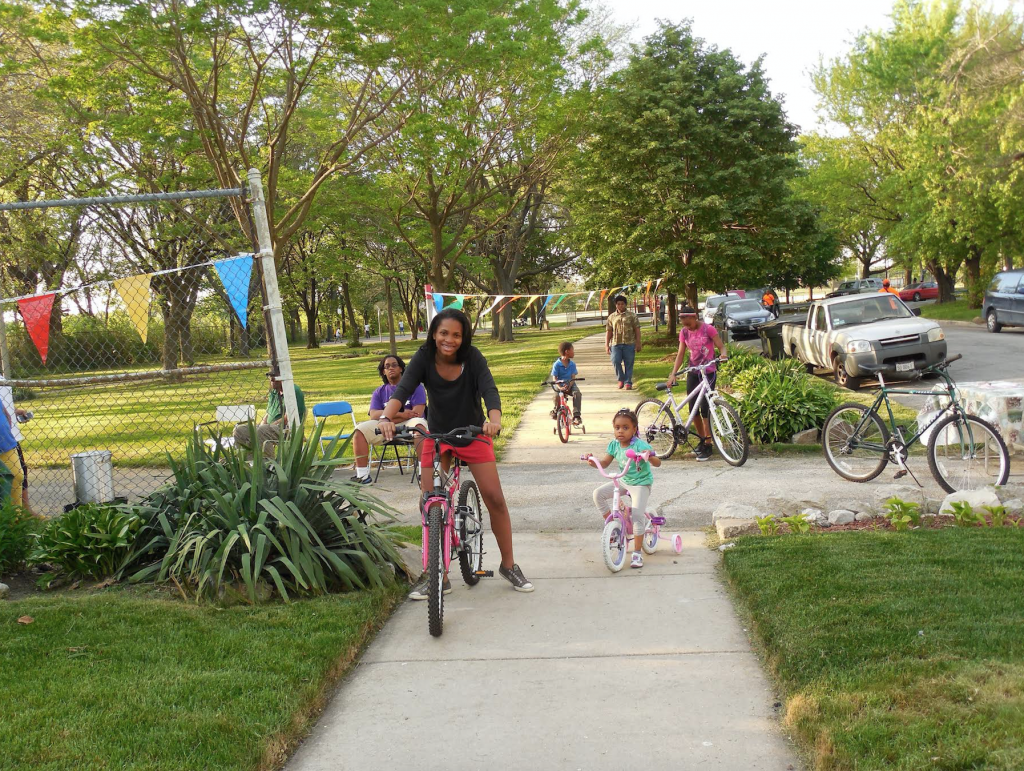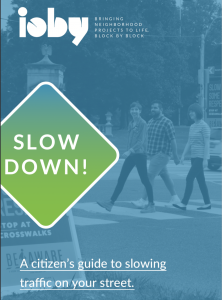“Historically, streets were not just for traffic,” writes David Engwicht, the irreverent public space thought leader, in his book Street Reclaiming: Creating Livable Streets and Vibrant Communities. “They were the epicenter of community life – a place for socializing, children’s play, drama, education, celebrations, social events, and economic activity. These important functions have been slowly eroded as car traffic has exerted its dominance.”
A glut of vehicular traffic—particularly of the high-speed variety—can quickly make your neighborhood feel less like a safe haven and more like the Autobahn. Luckily, there’s a lot you can do to help calm your community’s streets.
We’ve rounded up some of our favorite community-led traffic-taming measures. Every one of the ideas below has the potential to be acted on in collaboration with your neighbors—and many of them with your local government—because we hope that’s how you’ll choose to go about it. When residents work together to make their blocks safer, they also make them closer-knit and more resilient. That’s neighbor-led change, and civic power, at its best.

Community-led ways to stop cars from speeding on your block
Take action with your neighbors
- Look for existing initiatives. If speeding vehicles are a problem in your area, chances are other residents are concerned, too, so you may not need to start from scratch. Ask around, look for flyers, and search online community forums to see if anyone else is talking about the issue. You can look to get involved with what they’re doing, or just find out who’s shown an interest in taking action already—they could make great partners if you do wind up starting something new.
- Speak up. If you don’t see evidence of other speeding-related community initiatives in your area, or they don’t look to be active, start raising the issue with those around you. You can do this “officially,” at your neighborhood or homeowners association or other community meetings, as well as “unofficially” with your neighbors when you’re out getting your mail, with the other parents at your kid’s day care, or by posting flyers at the supermarket. Your goals in speaking up at this early stage are to a) get to know who else in your community is bothered by speeding traffic so you can work together to lessen it, and b) spread the word that this issue matters and people are paying attention—so speeders, watch out!
- Walk the walk—literally, if you can. This might sound obvious, but modeling good behavior is often a surprisingly easy and effective way to inspire it in others. When you drive in your neighborhood, make sure you’re driving at the same safe speed you want others to go, and encourage your friends and family to do the same. Driving more slowly literally slows down the traffic behind it, and moving at a reasonable pace sends everyone the message that this is a residential area, not a freeway. By the same token, try to walk or bike whenever you can. If your neighbors see you walking your kids to a playdate or biking to the bank—like WalkDenver’s Jill Locantore—it illustrates that non-car transportation is an option for many people (it also saves money, helps the environment, and provides exercise—how could you not want to model that?!). Plus, the more people out and about on sidewalks and streets (dressed like zebras or not), the more drivers are reminded to stay alert and ease up on the gas.
- Start a conversation, not a war. If you personally know any of your neighborhood’s repeat speeding offenders (or even if you don’t), it can be tough to ask them to slow down without raising their hackles. We like Rose Thibodeaux’s smart way to raise the issue without pointing fingers (it’s #1 on her list): If you use a home security camera, try using it to record speeders. Rose says, “Every so often I post a video of a commercial vehicle flying by my house and accompany it with a non-threatening message like, ‘Hey guys! Just wanted to let you know that I talked to the postmaster, the mail guy has been asked to obey the speed limit in our neighborhood.’ Never once have I called out a neighbor for speeding, but I’ve planted a seed. They know that at any given time I might post a picture of someone flying by my house. And guess what? On a daily basis, I can literally watch people hit the brakes BEFORE they pass my house. My house is a speed bump.”

Engage your local government
Bike and transit advocate Ted Buehler of Portland, Oregon put it well when he reasoned that “local governments are composed of human beings with the authority to take small actions if they’re provided with both a motive and an opportunity.” We would add that many ioby Leaders have advised being polite but persistent when endeavoring to work with the city, and to always keep your eyes on the prize.
- Speak up together. Who do you know that’s already doing something about speeding in your neighborhood, or would like to? Now is when you bring them together to approach your local government with a unified voice. ioby Leader Michalyn Easter of Memphis illustrated one great way to do this with her 311 phone bank group. Once a month, she convenes a group of her neighbors to make service requests to the city; last time we checked, their success rate was bordering on 100%. While one-off phone calls to your local police precinct or non-emergency service might bring a single squad car to your block one afternoon, there is usually more strength in numbers. If a bunch of neighbors submit requests on a regular basis, you’re much more likely to get sustained, serious support.
- Speak up on paper, on the phone, in person… There are so many ways a motivated group of people can present their case to the powers that be! Consider:
-
- Starting a shared spreadsheet online. Every time a neighbor sees an egregiously speeding car go by, he or she calls 311, the city’s traffic complaint hotline, police precinct’s patrol operations department, or other government service, then makes a note in the spreadsheet with the time, date, and location of the vehicle; a description of it; and a summary of the phone call. If 10 neighbors can concur that they’ve seen the same silver sedan zooming down the block in the same week—or worse, a commercial vehicle that’s not supposed to be on a residential street anyway—that driver’s speeding days are numbered.
-
- Connecting with local elected officials. While your county commissioner, state senator, or village trustee wouldn’t be the one issuing speeding tickets, appealing to these electeds can help put your problem on the city’s traffic enforcement or street redesign radars. In addition to stating your concerns and asking for support, you can elevate your dialogue (and gauge your rep’s prior experience with traffic safety concerns) by asking questions like, “What has the department of transportation done to successfully lower vehicle speeds in other areas of the city?” “Is the city currently interested in trying any new methods of traffic calming?” “What would you think about implementing Resident Only Parking on our street?”
- Appealing to the city’s goals. Many cities in the U.S. and internationally have adopted strategies like Vision Zero to reduce traffic fatalities and injuries and increase safe and equitable mobility. When your group reaches out to local government, you can mention that reducing vehicle speeds is a key element of these visionary plans—hint, hint. You can offer that either enforcing existing laws, like speed limits, and/or encouraging a desirable trend, like hiring more crossing guards, could serve both your group’s interests and the city’s own pledges.
-

Get physical!
-
- Make a day—and a demonstration—of it. ioby Leaders are masters of the car-free weekend event, the summer play street, the block party. These kinds of events, in all their iterations, get neighbors outside and meeting, eating, and playing together. They’re the perfect breeding ground for conversations about what could improve life on your street on a regular day—and they demonstrate to everyone who so much as glimpses them that streets are public property, not anyone’s private racetrack. Take extra inspiration from the projects selected for the Great Streets Challenge Grant, our partnership with L.A. Great Streets: all eight of them brought communities together in different ways specifically to re-envision the city’s roads as people-centric places.
- Go light on the infrastructure. There’s a lot to be said for traffic calming amenities like speed bumps, traffic circles, and chicanes (if you’re not familiar with that last term, this sweet claymation Streetfilm can explain). But they all have their issues, not the least of which is the time and expense that accompanies their design, approval, and construction. While resident groups may do very well to pursue street design elements like these, there are many lighter, quicker, and cheaper ways to reduce speeding where you live, with or without government involvement.
-
- Crosswalks. An oldie, but still a goodie!
-
- Artful paint. Street murals can beautify a neighborhood and provide its residents with a common project and source of pride. Happily, they also tend to make drivers slow down to get a look.
- Signs. Whether you petition the city for an official Stop or Yield sign or zip-tie your own “Please Slow Down: Kids Don’t Bounce” placard to a lamppost, a few words of warning can help.
-
- Get a twofer. Many speed-reducing initiatives come with other benefits built in. How about…
- Greening your street. Neighborhood greening projects like planting trees and growing a community garden can beautify your block, improve soil and air quality, and might even help with municipal stormwater management. As if that weren’t enough, there’s evidence that they encourage drivers to slow down and keep their cool.
- Starting a little free library. These miniature on-street book habitats offer passersby the chance to trade texts and foster an atmosphere of sharing. By bringing an interior look to an outdoor location, they also remind drivers that they’re in a residential area (so maybe they should drive like it).
- “Creating visual interest and surprise.” Think like the crafty Baltimoreans who brought out a potted tree, a steel sculpture, and a “snow family” in orange vests, among other interventions, to expand drivers’ awareness of their surroundings—and, we imagine, to have some fun. Planetizen’s write-up of their efforts quotes David Engwicht: “Playing ball in the street, decorating the yard, murals, sculptures—basically anything that creates visual interest and surprise—slows down vehicular traffic.”
- Go high tech. Electronic gauges like radar speed signs can help slow cars down.
- Or not. So can this woman—with her hair dryer.
